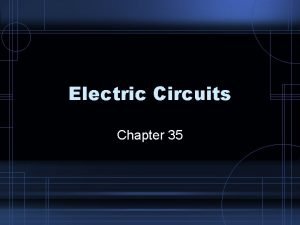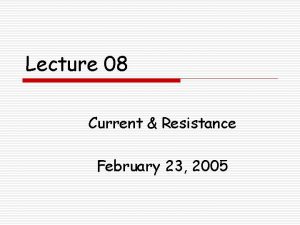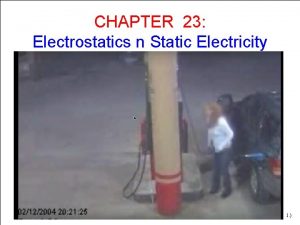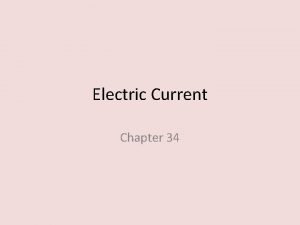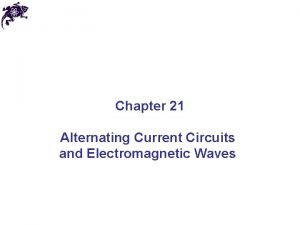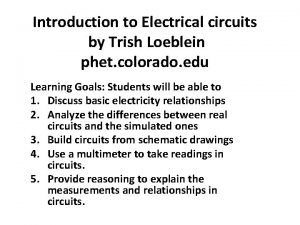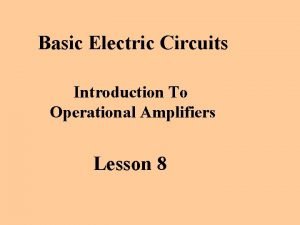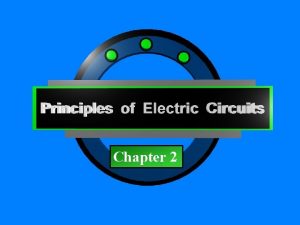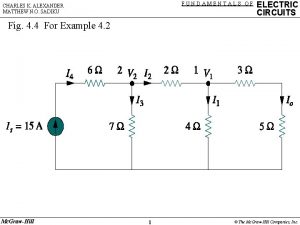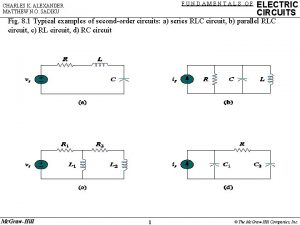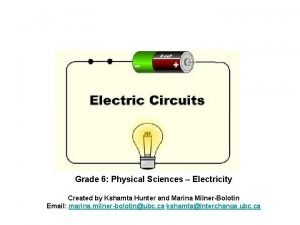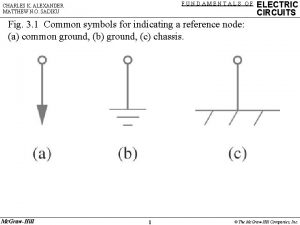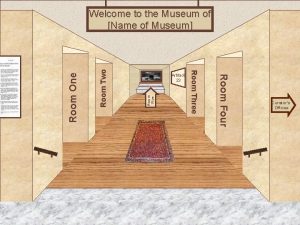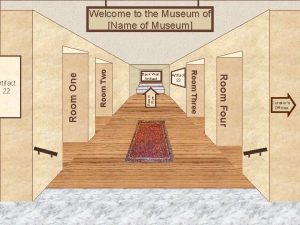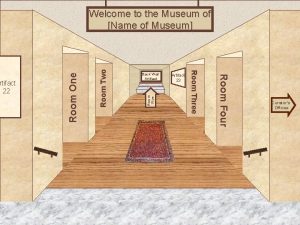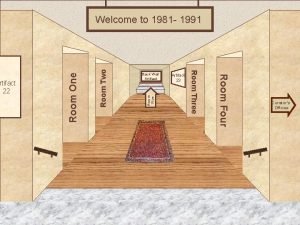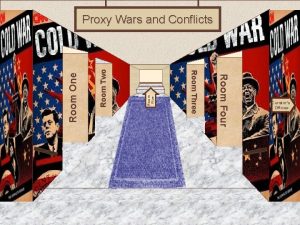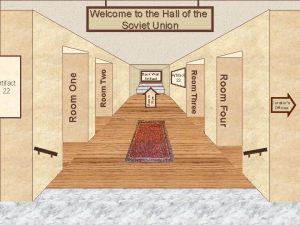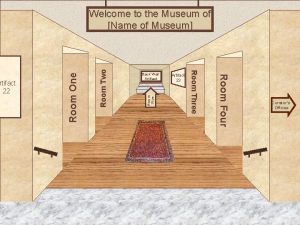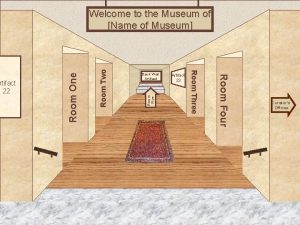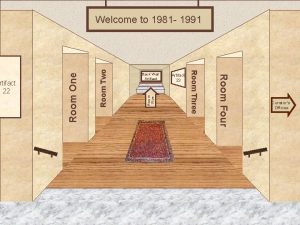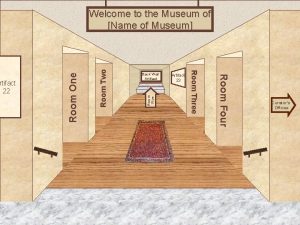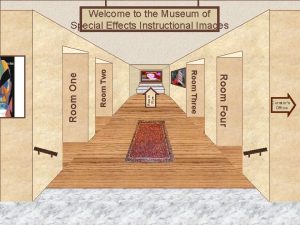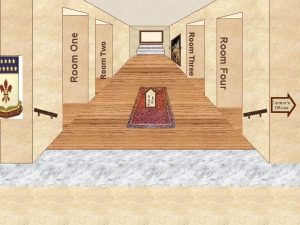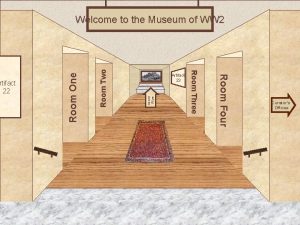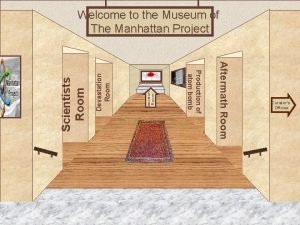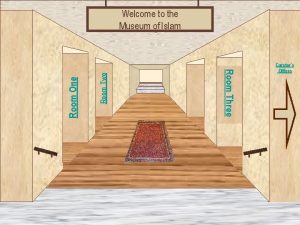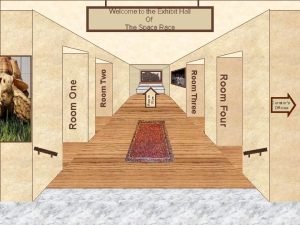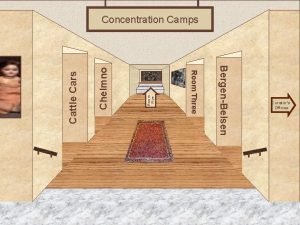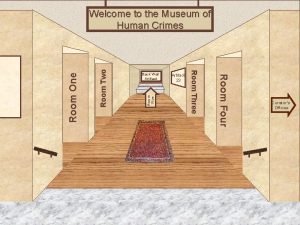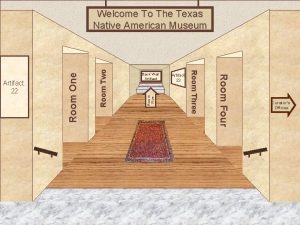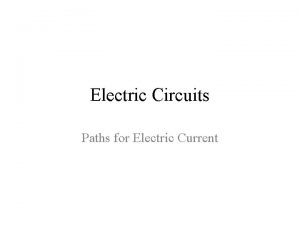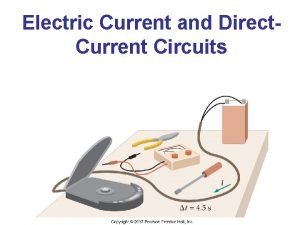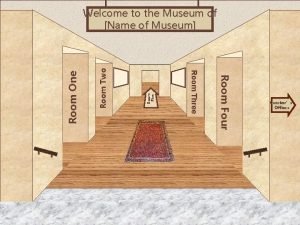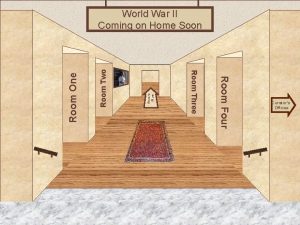Room Five Museum Entrance Circuits Electric Current Chapter




























- Slides: 28

Room Five Museum Entrance Circuits Electric Current Chapter Review Electrical Energy Electric Charge & Static Ch 17 Electricity Curator’s Offices

Created by Mrs. Childers’ 7 th per. AC Curator’s Class. Office Content Standards S 8 P 5 Students will recognize characteristics of gravity, electricity, and magnetism. a. b. Recognize that every object exerts gravitational force on every other and that the force exerted depends on how much mass the objects have and how far apart they are. Demonstrate the advantages and disadvantages of series and parallel circuits and how they transfer energy. c. Investigate and explain that electric currents and magnets can exert force on each other. Return to Entry Note: Virtual museums were first introduced by educators at Keith Valley Middle School in Horsham, Pennsylvania. This template was designed by Dr. Christy Keeler. View the Educational Virtual Museums website for more information on this instructional technique.

Electric Charge & Static Room 1 Static Electricity & Discharge Electrical Force & Electric Field Conduction, Induction, & Friction Return to Entry Moving Charges

Electric Current Room 2 AC DC Voltage Return to Entry Resistance

Generating Electrical Energy Room 3 Parts of a Cell Kinds of Cells Thermocouples Return to Entry Photocells

Circuits Room 4 Parts of A Circuit Series Circuits Parallel Circuits Return to Entry Household Circuit Safety

Chapter Review Room 5 Level III Super Nova Ultimate ? Of the Year Return to Entry Answer Key

Static Electricity & Discharge The Law of Electric Charges states that electric charges that are alike will always repel, but charges that are opposite will attract. Static electricity is caused by a buildup of negative electrons caused by two opposing surfaces rubbing against each other in opposite directions. Static electricity can be discharged through direct contact or through indirect contact and the attraction of opposite charges. Linked citation goes here Return to Exhibit

Electric Force & Electric Field The force between charged objects is an electric force. The size of the electric force depends in two things, the amount of charge on each object and the distance between the charges. Charged things are affected by electric force because charged things have an electric field around them. An electric field is the region around a charged object in which an electric force is exerted on another charged object. Linked citation goes here Return to Exhibit

Conduction, Induction, & Friction Induction. A process in which a shifting magnetic field is used to create electric voltage. Discovered by Joseph Henery & Michel Faraday This started a chain of events that led to alternating current, and without that modern technology couldn’t function. Frictiona force that resists movement when surface objects resist each other. No movement will occur unless a force greater then or equal to than the friction is applied. Conduction. When electrons move from one object to another by direct contact The first mechanical electrical generator, Michael Faraday's magneto-electric induction apparatus Return to Exhibit

Moving Charges Moving charges are surrounded by magnetic fields. Moving charges experience force when they move through fields. Conductors are materials that charges can move easily through. For example, cables and wires are made of metal. Electricity flows easily through metals. Insulators are materials that charges cannot move through easily. For example, cables and wires are surrounded by plastic. Electricity does not flow through plastic easily, and the electricity does not reach your hands. Linked citation goes here Return to Exhibit

AC There are two kinds of electric current. The one were talking about is alternating current (AC). AC comes from electrical currents from outlets in your home. Alternating Currents change directions an amazing amount of times. Actually in the U. S it changes directions up to 120 times every second! Usually AC goes through cycles. Every time the alternating current changes direction two times it goes through cycles. Return to Exhibit

DC DC stands for direct current. Direct current is measured in amperes (amps) along with all other types of currents. Direct current flows in one direction through an electric circuit. Return to Exhibit

Voltage is the strength of an electric current and it is also potential difference between two points in a circuit. It is expressed in volts. It is important to know that the symbol for volts is a capital “ v ” (V). You can think of voltage as the amount of energy released between two points in the path of the electrical current. The greater the voltage the greater strength the current can be. Volts are how battery companies measure the strength of a battery. Linked citation goes here Return to Exhibit

Resistance is the property of an electric circuit element that causes the current to convert power from electrical form to heat when electric current flows through the element. A resistor, a component connected to an electric circuit, provides resistance. An object’s resistance depends on the object’s material, thickness, length, and temperature. The higher resistance, the lower the current. Return to Exhibit

Parts of a Cell • Cell: a device that produces an electric current by converting chemical or radiant energy into electrical energy • Cells contain a mixture of chemicals • The chemicals, which are called electrolytes, allow charges to flow • Cells have a pair of electrodes • Electrodes: the part of the cell that is made from conducting materials and allows charges to enter and exit the cell • Chemical energy is converted in to electrical energy when chemical changes between the electrolyte and electrodes occur http: //cdnwww. greencar. com/images/hydrogen-fuelcells/How-Fuel-Cell-Works. jpg Return to Exhibit

Kinds of Cells • Cell: a device that produces an electric current by converting chemical or radiant energy to electrical energy • Electrolyte: a mixture of chemicals that allow charges to flow • There are 2 types of cells; wet and dry • Wet cells: • Have liquid electrolytes • Dry cells: • Have solid or paste-like electrolytes • http: //ventureinward. org/technology/review_files/wet_cel 0. gif • http: //media-2. web. britannica. com/eb-media/90/24090 -004 EC 128 E 8 C. gif Return to Exhibit

Thermocouples • Thermocouple: a device that converts thermal energy into electrical energy • Made by joining 2 different metals into a loop • When the 2 different kinds of wires are joined together it is called a junction • The temperature difference within the loop causes charges to flow through the loop • The greater the temperature difference, the greater the current • Thermocouples do not generate much energy • Discovered by a German physicist named T. J. Seebeck in 1821 http: //www. datapaq. com/images/Q 18 Relfow/Thermocouples_Large. jpg Return to Exhibit

Photocells • Photocell: a device constructed to change light energy into electrical energy • Contains silicon atoms • When light shines on the photocell, the electrons can move through a wire to provide electrical energy to power a device • Photocells are commonly used in solar panels http: //www. yourdictionary. com/images/comput er/_FOTOCEL. JPG Return to Exhibit

Parts of a Circuit All circuits need three basic parts: • Energy Source can be a battery, a photocell, a thermocouple, or an electric generator at a power plant. • Wires connect the other parts of a circuit. • Loads: i. e. . Light bulbs, appliances, televisions, and motors. Linked citation goes here Return to Exhibit

Series Circuits: Use a single path to connect the electric source or sources to the output device or devices. If a series circuit is drawn on paper, a line starting at any circuit part will pass through all the other circuit parts only once before returning to starting point. • For example, the circuit in a two battery flashlight connects the positive terminal of the second battery touches the center terminal of the flashlight bulb. If the switch is closed, the outer terminal of the bulb touches the negative terminal of the first battery, completing the circuit and lighting the bulb • Has a varying voltage depending on the number of its power sources • If one light bulb in a series circuit burns out, all the others will as well because the burned-out bulbs have opened the circuit. Linked citation goes here Return to Exhibit

Parallel Circuits: is a circuit in which loads are connected side by side. • Charges in a parallel circuit have more than one path in which they can travel. Unlike the loads in series circuits, a parallel circuit uses the same voltage. So, all of the loads have the same electricity content as the rest. • You can connect different loads that need different currents to the same circuit. Linked citation goes here Uses: • Each branch works by itself • If one load is broken or missing the other branches still work. • In a house, each electrical outlet is usually on its own branch. Return to Exhibit

Household Circuit Safety Circuit Failure: Broken wires or water can cause a short circuit. In a short circuit, charges do not go through one or more loads in a circuit. The resistance decrease, so the current increase. It eventually starts heating, enough to start a fire. Fuses and circuits breaker can help prevent fires from starting. Fuses: Charges in a circuit flow through a thin strip of metal in the fuse. If the current is too high the metal strip melts and the circuit is broken. Circuit Breakers: A switch that automatically opens if the current is too high, is called a circuit breaker. When the strip of metal in the breaker warms up, it bends and opens the switch which opens the circuit. Electrical Safety Tips: -Make sure the insulation on cords is not worn down. -Do not overload circuits by plugging in too many electrical devices. -Never put objects other than a plug in a Linked citation goes here Return to Exhibit

Level I 1. Opposites are to attract as likes are to……. a. repel b. turn over c. attract d. conduct 2. Protons and …… are included in the nucleus. a. electrons b. valence electrons c. neutrons d. charges 3. What are three ways that an electric charge can be received? a. electric discharge, friction, conduction b. electroscope, lightning, induction c. friction, conduction, induction d. law of electric charges, static, polar bears 4. What occurs when two objects are rubbed together in opposite directions? a. conduction b. insulation c. induction d. friction 5. What occurs when an uncharged metallic object is charged with out contact? a. induction b. electroscope c. static charge d. conduction 6. What unit are electric currents expressed in? a. AC and DC b. watts c. amps d. electrons 7. What is the opposition to the flow of electric charge? a. voltage b. resistance c. friction d. electric current 8. Resistance is expressed in what unit? a. joules b. volts c. watts d. ohms 9. What connects the parts of a circuit together? a. wires b. current c. electrons d. switch 10. What does a switch do? a. cuts the wire b. opens and closes the circuit c. keeps the wire straight d. provides extra power Return to Exhibit

Level II 1. What is AC/DC? a. An awesome Rock band b. A measure of resistance c. direct currents and alternating currents d. Parts of a cell or battery 2. Thermal energy can be converted into energy by use of a? a. Thermocouple c. Thermal converter b. Thermal Cell d. Thermal conductor 3. What is one way that you can conserve energy in your household? a. Use bigger toasters b. Leave your cell phone charger plugged into the outlet. c. Use a fan instead of A/C d. Use ceramic heaters 4. What is the effect of thickness and length on a. The time it takes for energy to flow b. Whether the circuit is open or closed. c. No difference at all. d. Determines the type of current it has. 5. What’s the difference between wet and dry cells? a. no difference b. Wet cells have electrolytes and the other doesn’t have liquid electrolytes. c. They make up batteries d. Dry have solid or paste like electrolytes. 6. What does a solar panel use to convert light energy to electrical energy? a. batteries b. Fuses c. thermocouples d. photocells 7. What is one thing you can do to protect yourself from electricity? a. wear oven mitts b. Make sure insulation cords aren’t worn c. Wear metal gloves d. Throw a banana at it. 8. What do cells do to make electrical energy? a. nothing b. . Discharges c. change chemical or radiant energy d. it collects electrolytes 9. How do you determine the electrical energy? a. With an electroscope b. Electrical energy = Power x Time c. You can’t d. Power ÷ Time = Electrical energy. 10. What is the standard voltage in an outlet in the U. S. ? Return to a. 200 v b. 140 v Exhibit c. 90 v d. 120 v

Level III 1. What happens to the metal leaves of an electroscope when it is electrically charged? a. b. c. d. 2. What is an electric field? a. the force of attraction or repulsion b. the space around a charged object c. opposites attracting and likes repelling d. the moving of electrons by electrons 3. What is an electric current? a. a current that moves 120 times a second b. a current that has 60 cycles a second c. the rate at which charges pass through a given point d. a current that uses the outlets at your home 4. What is a parallel circuit? a. a circuit in which all parts are connected in a single loop b. a gap between two pieces of conducting material c. a circuit in which the electricity doesn’t reach the battery again d. a circuit in which loads are connected side by side 5. If the circuit is too hot on the fuse, than the fuse……. ? a. melts b. becomes frozen c. transforms into a different element d. goes through sublimation Return to Exhibit 6. A GFCI primarily acts as a small……. a. power source b. fuse c. switch d. circuit breaker 7. In a short circuit, charges do not go through one or more……. . a. switches b. loads c. circuits d. electroscopes 8. Electrolytes allow …. . to flow. a. cells b. superconductors c. electrode d. charges 9. When the resistance in an object reaches 0 ohms, they are called …. . ? a. superconductor b. electrodes c. electrons d. electrolytes 10. What is an electrode? a. the part of a cell where charges enter and exit b. the part of a cell that changes radiant energy to electrical c. a type of circuit breaker d. mixes with electrolytes so charges flow easier

Answer Key • Level 1 1. 2. 3. 4. 5. 6. 7. 8. 9. 10. A B C D A B Level 2 1. A&C Level 3 2. A 1. A 3. C 2. B 4. A 3. C 5. B 4. D 6. D 5. A 7. B 6. B, D 8. C 7. B 9. B 8. D 10. D 9. A 10. A Super nova ?

Super Nova Ultimate ? Of the Year While waking up you scrape against your rugged carpet and then your favorite jazz song comes on. You start doing the Moon Walk but, you bump into you shag rug carpet walls and cause your cat to fall off the fan. Your cat freaks out causing you to gain more static electricity from the friction of his claws on your face. Then you jump on the tread mill which is going so fast. You try to hold on to the bars , but your feet skid on the rubber. When you can’t hold on any longer you get rammed into the wall. You feel very strange as you walk toward the door. When you touch the door knob everything goes black. How many electrons did you loose? A. Everything is still dark… B. When did I get shag rug walls? C. I see a light… D. 2000 volts. E. I don’t own a cat… F. Darn Linkedraccoon citation goes here G. 4 volts Return to Exhibit
 Let's look at some examples
Let's look at some examples Fundamentals of electric circuits chapter 4 solutions
Fundamentals of electric circuits chapter 4 solutions Electric current
Electric current Conceptual physics chapter 35 electric circuits
Conceptual physics chapter 35 electric circuits Chapter 20 electric circuits
Chapter 20 electric circuits Fundamentals of electric circuits chapter 9 solutions
Fundamentals of electric circuits chapter 9 solutions Fundamentals of electric circuits chapter 7 solutions
Fundamentals of electric circuits chapter 7 solutions Chapter 35 electric circuits answers
Chapter 35 electric circuits answers Circuits ohm's law worksheet answers
Circuits ohm's law worksheet answers Chapter 35 electric circuits
Chapter 35 electric circuits Current in a parallel circuit
Current in a parallel circuit Chapter 23 electric current circuit happenings
Chapter 23 electric current circuit happenings Electricity
Electricity Chapter 34 electric current
Chapter 34 electric current Chapter 21 electric charge and electric field
Chapter 21 electric charge and electric field Chapter 21 electric charge and electric field
Chapter 21 electric charge and electric field Coulombs constant units
Coulombs constant units Dc o/d per item charge
Dc o/d per item charge Alternating current circuits and electromagnetic waves
Alternating current circuits and electromagnetic waves Phet electric circuit
Phet electric circuit Electric circuits equations
Electric circuits equations Electric circuits nilsson
Electric circuits nilsson Principle of electric circuit
Principle of electric circuit Electrical circuit elements
Electrical circuit elements Sadiku
Sadiku Fundamentals of electric circuits
Fundamentals of electric circuits Superposition electric circuits
Superposition electric circuits Kshamta hunter
Kshamta hunter Fundamentals of electric
Fundamentals of electric









